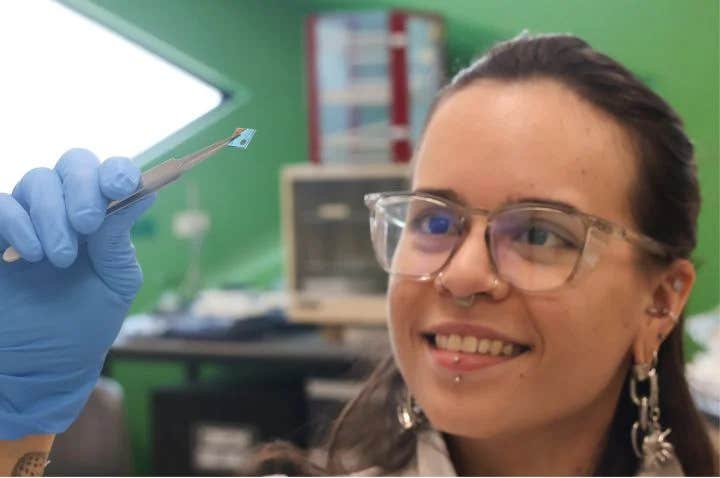Invisible material brings a new era of touch screens and wearable devices
A face-serum staple just helped a research team build an invisible film that conducts electricity like a metal.

Researchers at La Trobe University have developed a highly conductive new material capable of carrying electricity with exceptional efficiency. (CREDIT: La Trobe University)
A face-serum staple just helped a research team build an invisible film that conducts electricity like a metal. At La Trobe University in Melbourne, the group used hyaluronic acid to guide the growth of a new two-dimensional polymer on gold.
The ultrathin coating, called 2D PEDOT, could boost touchscreens and make medical wearables smaller, tougher, and more precise. The work appears in ACS Applied Materials and Interfaces and was led by Associate Professor Wren Greene with senior researcher Dr Saimon Moraes Silva and PhD candidate Luiza Aguiar do Nascimento at the Biomedical and Environmental Sensor Technology Research Centre.
“Conductive polymers as we know them were developed nearly 50 years ago and although they’re exciting, they haven’t lived up to their potential in that time. Often they are difficult to fabricate, as thin films don’t conduct electricity very well, aren’t transparent and can have highly variable properties,” Dr Greene said.
Tethered Dopant Templating
“Through our method, called ‘tethered dopant templating’, we’ve created a robust way of making a conductive polymer that is flexible, durable, can conduct electricity as well as metals and is easily reproduced – so it’s scalable.”
The team reports films about three nanometers thick that cover square-centimeter areas with uniform performance. The hyaluronic acid acts as a bound dopant layer on the gold. That anchored layer steers the polymerization of EDOT monomers into longer, cleaner chains. The result is a transparent, flexible conductor that handles charge like a metal but behaves like a soft coating.
“We were very excited to find that not only did the polymers form when we tethered directly to the gold, but that these polymers were thinner, more powerfully conductive and almost foolproof to reproduce,” Luiza Aguiar do Nascimento said.
Related Stories
- Smart Textiles: A New Era of Wearable Technology
- New 3D printing process creates recyclable plastics that stretch and flex
“Currently, it is difficult to consistently reproduce conductive polymers at the high quality needed for health and medical monitoring and drug delivery devices,” Dr Moraes Silva said. “I’m excited that we have created new capabilities for these materials which are scalable, affordable and reproducible.”
What the new film changes
Phones, watches, and medical patches rely on conductive layers that move charge while staying clear and thin. Today’s standards include indium tin oxide and variants of PEDOT:PSS. Each option has tradeoffs. Indium tin oxide is brittle. PEDOT:PSS is soft but often loses conductivity when made thin or stretched. The La Trobe group reports metal-class conductivity in a film that is thinner than a virus, yet remains transparent and uniform. That mix could shrink sensors, cut power loss, and reduce material costs.
The film also forms in open space rather than in cramped stacks or pores. Past 2D polymer methods confined growth between lipid bilayers, oil films, or clays. Those cramped routes slowed reactions to many hours or days and produced only flakes or colloids. The La Trobe method uses electricity and a “tethered” dopant layer to grow a continuous 2D film across a flat electrode in minutes. The process offers patterning control, scale, and strong batch-to-batch repeatability.
How ‘tethered dopant templating’ works
In standard electropolymerization, chemists dissolve a dopant along with the monomer. That soup produces variable films with uneven doping and mixed chain lengths. By contrast, tethered dopant templating attaches a dense, anionic macromolecule—here, hyaluronic acid—directly to the gold surface. When voltage is applied, monomers oxidize at the interface and link up into PEDOT chains that grow along the anchored dopant.
As chains extend, the bound dopant guides growth and suppresses chain termination. Longer chains raise mobility. The dopant also packs into the film at very high ratios—reported up to eight parts dopant by mass for each part polymer. That “hyper-doping” increases the number of charge carriers. Together, long chains and high carrier density push the film into metal-like conductivity while keeping it molecular-scale thin.
Why this matters for wearables and implants
Wearable biosensors must be soft, stable, and clear. They also need signal fidelity and low power loss. The 2D PEDOT film is invisible to the eye yet conducts like a wire. Hyaluronic acid is already used in skin care and injectable gels, which supports biocompatibility goals. The film’s uniformity at sub-micrometer scales should reduce hot spots and noise in bio-signal pickup. The method could also pattern electrodes at high density, enabling richer mapping of heart, muscle, and brain activity with less irritation.
Drug delivery patches and implant leads stand to gain as well. A tougher, thinner conductor can reduce device bulk and improve comfort. Metal-like performance in a polymer could extend battery life. It may also enable stretchable interconnects that survive repeated bending, sweat, and body heat without losing function.
Tethered dopant templating in focus
Tethered dopant templating underpins each reported gain. The surface-bound hyaluronic acid shapes growth in three dimensions and sets a hard stop on thickness. That control yields smooth, continuous films at nanometer scale with even properties. Direct tethering also removes the need for salt electrolytes during growth. That step avoids later rinses and cuts ionic residues that often cause drift in sensors.
The team’s results show tight control over charge transport and optical clarity. With conductivity in the metal range, the film handles high-speed signals without added thickness. With molecular-scale height, it stays almost perfectly transparent. Those traits open a path to next-gen transparent conductors for displays and optical biosensors.
From lab method to production line
The group reports growth over areas measured in square centimeters using standard electrodes. The approach fits with wafer-scale tools and roll-to-roll plating. Because the dopant is pre-grafted to the surface, each cycle starts from a known state. That makes inline quality control more reliable. The process also enables direct patterning by printing or masking the dopant layer before growth, avoiding brittle etch steps after deposition.
The researchers emphasize scalability. They showed that films grown with tethered dopant templating present near-identical properties across a sample and across repeats. That uniformity is essential for mass production of touch panels and biosensor arrays. If production moves forward, it could reduce reliance on indium and cut the embodied energy of display stacks.
Where the field stands now
Conductive polymers have matured over five decades, but thin, clear, and very conductive films remain rare. Recent work on PEDOT:PSS has improved performance by acid rinses and salt treatments, raising conductivity and long-term stability. A parallel thread focuses on hybrid films with silver nanowires or graphene to boost both clarity and conductance. Reviews of bioelectronic interfaces highlight PEDOT’s value in brain and nerve monitoring. Yet many routes still struggle with roughness, pinholes, and drift.
The La Trobe study advances a distinct idea: control the reaction from the surface outward using a tethered dopant. By doing so, it achieves stable metal-like behavior in a film only a few molecules thick. That combination—molecular scale, metal-class conductance, and large area—could reset expectations for soft electrodes in medicine and consumer tech.
What comes next
Key tests will probe aging under sweat, UV light, and thousands of bends. Adhesion to glass and polymers used in screens must be proven. Biocompatibility will need direct studies in tissue models and animal systems. If those hurdles are cleared, the films could appear first in high-end touch sensors and point-of-care test strips. Clinical devices may follow after safety and reliability trials.
The team’s BEST Centre sits at the intersection of materials and sensing. That setting suggests rapid spin-outs in biosensing and optical readouts. With partners in display and medical device manufacturing, this method could reach pilot production in the near term.
Past Studies and Findings
Researchers have spent years tuning PEDOT:PSS films with acid and salt treatments to boost conductivity and stability. A 2025 study in ACS Applied Materials and Interfaces reported metal-like conductance in acid-treated PEDOT:PSS using a simple process, hinting at routes to rival brittle oxides in transparent electrodes.
Work in 2024 and 2025 refined PEDOT:PSS electrodes for durability. Sequential treatment with nitric acid and cesium chloride enhanced long-term stability, a key need for implants and long-wear sensors. These efforts show how chemical control can raise charge mobility and lessen drift in thin films.
Other teams combined PEDOT:PSS with silver nanowires to balance clarity and low sheet resistance. Hybrid films achieved strong optical and electrical metrics, while recent methods engineered vertical phase separation to tune surface chemistry for tissue contact. These strategies show the wide push to merge high conductivity with soft mechanics for biointerfaces.
In parallel, reviews of wearable biosensors traced steady gains in polymer electrodes, hydrogels, and stretchable conductors. These studies, published in ScienceDirect and MDPI, described how PEDOT and related polymers capture faint biochemical and electrical signals during motion. New hydrogels improved self-healing and comfort, matching the need for sports and health tracking.
The La Trobe group’s approach differs by growing a true 2D conducting polymer in open space. It uses hyaluronic acid tethered to gold to guide chain growth, producing uniform, ultrathin, “hyper-doped” films with dopant-to-polymer mass ratios up to 8:1 and thickness near three nanometers across centimeter-scale areas. The team attributes the metal-like behavior to both longer chains and higher carrier density, with submicrometer homogeneity confirmed by localized electrochemistry and imaging.
Practical Implications of the Research
Better transparent conductors could extend battery life and shrink wearable devices. A few nanometers shaved from each display or sensor stack can reduce weight and improve comfort. Uniform, metal-class conductive polymers may also lower cost by replacing brittle oxides that demand careful handling and rare elements.
In health care, consistent and clear electrodes can boost signal quality for heart and brain monitoring. Thin and soft coatings reduce skin irritation, support longer wear, and improve adhesion to curved surfaces. If biocompatibility holds, implantable leads and stimulation pads could move toward softer, safer materials. The method also invites greener processes, since it avoids heavy baths of mobile salts and enables precise growth with fewer rinse steps.
What We've Learned
- A tethered dopant layer can grow a uniform, three-nanometer 2D PEDOT film with metal-like conductivity.
- The method improves scalability, patterning, and reproducibility for clear, flexible electrodes.
- Wearables and medical sensors could gain longer life, smaller size, and better signal quality.
Note: The article above provided above by The Brighter Side of News.
Like these kind of feel good stories? Get The Brighter Side of News' newsletter.



